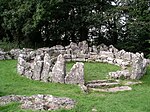St Eugrad's Church, Llaneugrad

St Eugrad's Church, Llaneugrad is an isolated church near the village of Marian-glas, in Anglesey, north Wales. A church was supposedly founded here by St Eugrad in about 605, although the earliest parts of the present structure are the nave, chancel and chancel arch, which date from the 12th century. A side chapel was added to the north in the 16th century, and some moderate restoration work was carried out in the 19th century. It contains a 12th-century font, a 13th-century carved stone depicting the crucifixion, and a memorial to one of the officers killed when the Royal Charter sank off Anglesey in 1859. The church is still used for worship by the Church in Wales, one of four in a combined parish; one of the others is St Gallgo's Church, Llanallgo, founded by Eugrad's brother. As of 2012, the parish does not have an incumbent priest. St Eugrad's is a Grade II* listed building, a national designation given to "particularly important buildings of more than special interest", in particular because it is regarded as a "simple rural church" and "characteristic of the island", and because of the medieval fabric including the chancel arch, described as "a rare survivor of an early building date for the region."
Excerpt from the Wikipedia article St Eugrad's Church, Llaneugrad (License: CC BY-SA 3.0, Authors, Images).St Eugrad's Church, Llaneugrad
Lôn Las,
Geographical coordinates (GPS) Address Nearby Places Show on map
Geographical coordinates (GPS)
| Latitude | Longitude |
|---|---|
| N 53.332948 ° | E -4.260584 ° |
Address
Lôn Las
LL78 7JG , Llaneugrad
Wales, United Kingdom
Open on Google Maps









